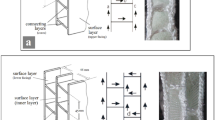Abstract
Nonwoven fabrics and rigid polyurethane foam(PUF) are commonly used materials as building materials, but there are few studies on combining both materials and reporting characteristic evaluations for the application. In this study, N/L/Fr nonwoven fabrics are combined with PUF to produce N/PUF composites, and then a needle punching machine is used for perforation, thereby produces perforated N/PUF composites. With PUF densities being 70 kg/m3 and 80 kg/m3, a perforation depth of 100 % results in significantly decreasing mechanical properties. Based on the results of thermal conductivity coefficient, the employment of needle punch process results in a decrease in the thermal insulation of N/PUF composite; however, the descending level is comparatively smaller when PUF is made of a greater density. In the thermogravimetric analysis (TGA), the char residue is 4.86 % for PUF and 11.68 % for N/PUF composites, indicating that N/L/Fr nonwoven fabrics improve the thermal stability of PUF. As per limiting oxygen index (LOI), the part of proposed N/PUF composites that first contacts the flame is N/L/Fr nonwoven fabrics, which causes an LOI of 33 when in practical application and resembles the LOI (33) of N/L/Fr nonwoven fabrics. Based on the test results, the optimal perforated N/PUF composites are made of a PUF density of 80 kg/m3 and a perforation depth of 75 %, and the optimal compression strength is 375.29 kPa, which increases by 10.96 %. In addition, the proposed products have the same impact absorption capacity (5.88 J) as that of N/PUF composites, which absorb a total of 98.16 % impact energy. The sound absorption is improved in the frequency band of 800–2500 Hz, which broadens the sound absorption bandwidth and benefits the application as being sound absorbent materials.
Similar content being viewed by others
References
H. Xie, W. Yang, A. C. Y. Yuen, C. Xie, J. Xie, H. Lu, and G. H. Yeoh, Chem. Eng. J., 311, 310 (2017).
W. Xi, L. Qian, Z. Huang, Y. Cao, and L. Li, Polym. Degrad. Stabil., 130, 97 (2016).
C. A. Echeverria, F. Pahlevani, W. Handoko, C. Jiang, C. Doolan, and V. Sahajwalla, Resour. Conserv. Recycl., 143, 1 (2019).
Z. Talebi, P. Soltani, N. Habibi, and F. Latifi, Constr. Build. Mater., 220, 76 (2019).
X. Ji, H. Zhang, Z. Bai, G. Qiu, M. Guo, F. Cheng, and M. Zhang, Energ. Buildings, 205, 109533 (2019).
X. Zhao and X. Fan, Appl. Acoust., 88, 123 (2015).
S. K. Tang, C. H. Ng, and E. Y. L. Lam, Appl. Acoust., 73, 969 (2012).
S.-H. Park, Sound Vib., 332, 4895 (2013).
X.-D. Zhao, Y.-J. Yu, and Y.-J. Wu, Appl. Acoust., 114, 92 (2016).
S. Islam and G. Bhat, J. Environ. Manage., 251, 109536 (2019).
D. M. S. Al-Homoud, Build. Environ., 40, 353 (2005).
A. Hadded, S. Benltoufa, F. Fayala, and A. Jemni, J. Build. Eng., 5, 34 (2016).
A. Hao, H. Zhao, and J. Y. Chen, Compos. Part B-Eng., 54, 44 (2013).
D.-A. Şerban, O. Weissenborn, S. Geller, L. Marşavina, and M. Gude, Polym. Test., 49, 121 (2016).
S. Nam, B. D. Condon, Z. Xia, R. Nagarajan, D. J. Hinchliffe, and C. A. Madison, J. Anal. Appl. Pyrol., 126, 239 (2017).
L. Qian, L. Li, Y. Chen, B. Xu, and Y. Qiu, Compos. Part B-Eng., 175, 107186 (2019).
L. Liu and Z. Wang, Polym. Degrad. Stabil., 154, 62 (2018).
C. S. Carriço, T. Fraga, and V. M. D. Pasa, Eur. Polym. J., 85, 53 (2016).
X. Luo, A. Mohanty, and M. Misra, Ind. Crop. Prod., 47, 13 (2013).
M. Zieleniewska, M. K. Leszczyński, L. Szczepkowski, A. Bryśkiewicz, M. Krzyżowska, K. Bień, and J. Ryszkowska, Polym. Degrad. Stabil., 132, 78 (2016).
N. V. Gama, R. Silva, F. Mohseni, A. Davarpanah, V. S. Amaral, A. Ferreira, and A. Barros-Timmons, Polym. Test., 69, 199 (2018).
Z. Zhang, D. Li, M. Xu, and B. Li, Polym. Degrad. Stabil., 173, 109077 (2020).
N. N. P. Nik Pauzi, R. A. Majid, M. H. Dzulkifli, and M. Y. Yahya, Compos. Part B-Eng., 67, 521 (2014).
Y.-C. Chuang, T.-T. Li, C.-H. Huang, C.-L. Huang, C.-W. Lou, Y.-S. Chen, and J.-H. Lin, Fiber. Polym., 17, 2116 (2016).
J.-H. Lin, T.-T. Li, C.-H. Huang, Y.-C. Chuang, and C.-W. Lou, Fiber. Polym., 16, 2046 (2015).
A. A. Septevani, D. A. C. Evans, P. K. Annamalai, and D. J. Martin, Ind. Crop. Prod., 107, 114 (2017).
N. Gama, L. C. Costa, V. Amaral, A. Ferreira, and A. Barros-Timmons, Compos. Sci. Technol., 138, 24 (2017).
J. Lee, G.-H. Kim, and C.-S. Ha, J. Appl. Polym. Sci., 123, 2384 (2012).
T.-T. Li, Y.-C. Chuang, C.-H. Huang, C.-W. Lou, and J.-H. Lin, Fiber. Polym., 16, 691 (2015).
H. Meng, M. A. Galland, M. Ichchou, O. Bareille, F. X. Xin, and T. J. Lu, Compos. Struct., 182, 1 (2017).
S. Xie, D. Wang, Z. Feng, and S. Yang, Applied Acoustics, 158, 107046 (2020).
S. Villar-Rodil, A. Martínez-Alonso, and J. M. D. Tascón, J. Anal. Appl. Pyrol., 58–59, 105 (2001).
Y. Pan, L. Liu, X. Wang, L. Song, and Y. Hu, Carbohydr. Polym., 201, 1 (2018).
L. Liu and Z. Wang, Mater. Chem. Phys., 219, 318 (2018).
W.-H. Rao, H.-X. Xu, Y.-J. Xu, M. Qi, W. Liao, S. Xu, and Y.-Z. Wang, Chem. Eng., 343, 198 (2018).
Z.-J. Cao, X. Dong, T. Fu, S.-B. Deng, W. Liao, and Y.-Z. Wang, Polym. Degrad. Stabil., 136, 103 (2017).
R. Yang, B. Wang, X. Han, B. Ma, and J. Li, Polym. Degrad. Stabil., 144, 62 (2017).
Acknowledgements
Ministry of Science and Technology of Taiwan (MOST) 107-2221-E-035-049-MY2 and (MOST) 106-2622-E-035-013-CC3.
Author information
Authors and Affiliations
Corresponding authors
Rights and permissions
About this article
Cite this article
Ou, RR., Huang, CH., Lou, CW. et al. Structural Design and Property Evaluations of Foam-based Composite Materials: Effect of Perforation Depth and Foam Density on the Mechanical, Sound Absorption, and Thermal Properties. Fibers Polym 22, 587–596 (2021). https://doi.org/10.1007/s12221-021-0186-8
Received:
Revised:
Accepted:
Published:
Issue Date:
DOI: https://doi.org/10.1007/s12221-021-0186-8



